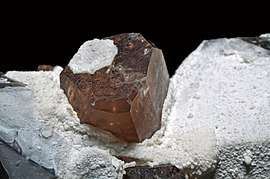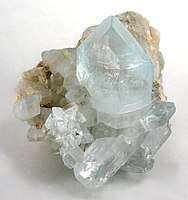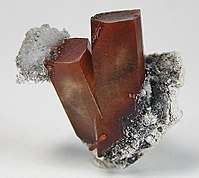Topaz
Topaz is a silicate mineral of aluminium and fluorine with the chemical formula Al2SiO4(F, OH)2. Topaz crystallizes in the orthorhombic system, and its crystals are mostly prismatic terminated by pyramidal and other faces. It is one of the hardest naturally occurring minerals (Mohs hardness of 8) and is the hardest of any silicate mineral. This hardness combined with its usual transparency and variety of colors means that it has acquired wide use in jewellery as a cut gemstone as well as for intaglios and other gemstone carvings.[5]
| Topaz | |
|---|---|
 Topaz crystal on white matrix | |
| General | |
| Category | Nesosilicate minerals |
| Formula (repeating unit) | Al2SiO4(F,OH)2 |
| Strunz classification | 9.AF.35 |
| Crystal system | Orthorhombic |
| Crystal class | Dipyramidal (mmm) H-M symbol: (2/m 2/m 2/m) |
| Space group | Pbnm |
| Unit cell | a = 4.65 Å, b = 8.8 Å, c = 8.4 Å; Z = 4 |
| Identification | |
| Color | Colorless (if no impurities), white, blue, brown, orange, gray, yellow, yellowish brown, green, pink and reddish pink, red |
| Crystal habit | Prismatic crystal |
| Cleavage | [001] Perfect |
| Fracture | Subconchoidal to uneven |
| Mohs scale hardness | 8 (defining mineral) |
| Luster | Vitreous |
| Streak | White |
| Diaphaneity | Transparent |
| Specific gravity | 3.49–3.57 |
| Optical properties | Biaxial (+) |
| Refractive index | nα = 1.606–1.629 nβ = 1.609–1.631 nγ = 1.616–1.638 |
| Birefringence | δ = 0.010 |
| Pleochroism | Weak in thick sections X = yellow; Y = yellow, violet, reddish; Z = violet, bluish, yellow, pink |
| Ultraviolet fluorescence | Short UV=golden yellow; Long UV=cream |
| References | [1][2][3][4] |
Characteristics


Topaz in its natural state is a golden brown to yellow – a characteristic which means it is sometimes confused with citrine, a less valuable gemstone.[5] A variety of impurities and treatments may make topaz wine red, pale gray, reddish-orange, pale green, or pink (rare), and opaque to translucent/transparent. The pink and red varieties come from chromium replacing aluminium in its crystalline structure.
Orange topaz, also known as precious topaz, is the conventional birthstone for November, the symbol of friendship, and the state gemstone of the U.S. state of Utah.[6]
Imperial topaz is yellow, pink (rare, if natural) or pink-orange. Brazilian imperial topaz can often have a bright yellow to deep golden brown hue, sometimes even violet. Many brown or pale topazes are treated to make them bright yellow, gold, pink, or violet colored. Some imperial topaz stones can fade on exposure to sunlight for an extended period of time.[7][8]
Blue topaz is the state gemstone of the US state of Texas.[9] Naturally occurring blue topaz is quite rare. Typically, colorless, gray, or pale yellow and blue material is heat treated and irradiated to produce a more desired darker blue.[8]
Mystic topaz is colorless topaz which has been artificially coated via a vapor deposition process giving it a rainbow effect on its surface.[10]
Although very hard, topaz must be treated with greater care than some other minerals of similar hardness (such as corundum) because of a weakness of atomic bonding of the stone's molecules along one or another axial plane (whereas diamonds, for example, are composed of carbon atoms bonded to each other with equal strength along all of its planes). This gives topaz a tendency to break along such a cleavage plane if struck with sufficient force.[11]
Topaz has a relatively low index of refraction for a gemstone, and so stones with large facets or tables do not sparkle as readily as stones cut from minerals with higher refractive indices, though quality colorless topaz sparkles and shows more "life" than similarly cut quartz. When given a typical "brilliant" cut, topaz may either show a sparkling table facet surrounded by dead-looking crown facets or a ring of sparkling crown facets with a dull well-like table.[12]
Localities and occurrence
Topaz is commonly associated with silicic igneous rocks of the granite and rhyolite type. It typically crystallizes in granitic pegmatites or in vapor cavities in rhyolite lava flows including those at Topaz Mountain in western Utah and Chivinar in South America. It can be found with fluorite and cassiterite in various areas including the Ural and Ilmensky Mountains of Russia, in Afghanistan, Sri Lanka, Czech Republic, Germany, Norway, Pakistan, Italy, Sweden, Japan, Brazil, Mexico; Flinders Island, Australia; Nigeria and the United States.
Brazil is one of the largest producers of topaz,[13] some clear topaz crystals from Brazilian pegmatites can reach boulder size and weigh hundreds of pounds. The Topaz of Aurangzeb, observed by Jean Baptiste Tavernier weighed 157.75 carats.[14] The American Golden Topaz, a more recent gem, weighed a massive 22,892.5 carats. Large, vivid blue topaz specimens from the St. Anns mine in Zimbabwe were found in the late 1980s.[15]
Colorless and light-blue varieties of topaz are found in Precambrian granite in Mason County, Texas[16] within the Llano Uplift. There is no commercial mining of topaz in that area.[17]
 Topaz Mountain, Utah
Topaz Mountain, Utah Sherry-colored topaz from Maynard's Claim (Pismire Knolls), Thomas Range, Juab County, Utah, USA
Sherry-colored topaz from Maynard's Claim (Pismire Knolls), Thomas Range, Juab County, Utah, USA Blue Topaz from Erongo Mountain, Usakos and Omaruru Districts, Erongo Region, Namibia
Blue Topaz from Erongo Mountain, Usakos and Omaruru Districts, Erongo Region, Namibia Red topaz from Tepetate, Municipio de Villa de Arriaga, San Luis Potosí, Mexico
Red topaz from Tepetate, Municipio de Villa de Arriaga, San Luis Potosí, Mexico
Synthetic topaz
It is possible to synthesize topaz.[18] However, naturally occurring topaz is so abundant that this is probably not economically viable.
Etymology
The name "topaz" is usually derived (via Old French: Topace and Latin: Topazus) from the Greek Τοπάζιος (Τοpáziοs) or Τοπάζιον (Τοpáziοn),[19] from Τοπαζος, the ancient name of St. John's Island in the Red Sea which was difficult to find and from which a yellow stone (now believed to be chrysolite: yellowish olivine) was mined in ancient times; topaz itself (rather than topazios) was not really known before the classical era. Ancient Sri Lanka (Tamraparni) exported native oriental topazes to Greece and ancient Egypt, which led to the etymologically related names of the island by Alexander Polyhistor (Topazius) and the early Egyptians (Topapwene) – "land of the Topaz".[20][21] Pliny said that Topazos is a legendary island in the Red Sea and the mineral "topaz" was first mined there. Alternatively, the word topaz may be related to the Sanskrit word तपस् "tapas", meaning "heat" or "fire".[19]
Historical usage
Nicols, the author of one of the first systematic treatises on minerals and gemstones, dedicated two chapters to the topic in 1652.[22] In the Middle Ages, the name topaz was used to refer to any yellow gemstone, but in modern times it denotes only the silicate described above.
Many English translations of the Bible, including the King James Version, mention topaz. However, because these translations as topaz all derive from the Septuagint translation topazi[os], which referred to a yellow stone that was not topaz, but probably chrysolite (chrysoberyl or peridot), topaz is likely not meant here.[23]
Superstition
An English superstition also held that topaz cured lunacy.[24] The ancient Romans believed that topaz provided protection from danger while traveling. [25] During the Middle Ages, it was believed that attaching the topaz to the left arm protected the owner from any curse and warded off the evil eye. It was also believed that wearing topaz increased body heat, which would enable people to relieve a cold or fever. [26] In Europe in the Middle Ages, topaz was believed to enhance mental powers.[27]
References
- Hurlbut, Cornelius S.; Klein, Cornelis, 1985, Manual of Mineralogy, 20th ed., ISBN 0-471-80580-7
- Anthony, John W.; Bideaux, Richard A.; Bladh, Kenneth W.; Nichols, Monte C., eds. (1995). "Topaz" (PDF). Handbook of Mineralogy. II (Silica, Silicates). Chantilly, VA, US: Mineralogical Society of America. ISBN 978-0-9622097-1-0. Retrieved December 5, 2011.
- Topaz. Mindat.org. Retrieved on 2011-10-29.
- Topaz. Webmineral.com. Retrieved on 2011-10-29.
- Hurrell, Karen; Johnson, Mary L. (15 December 2016). Gemstones: A Complete Color Reference for Precious and Semiprecious Stones of the World. Book Sales. p. 169. ISBN 978-0-7858-3498-4.
- "Utah State gem – Topaz". Pioneer.utah.gov. 16 June 2010. Retrieved 29 October 2011.
- "Imperial topaz". nhm.org. Natural History Museum of Los Angeles County. Archived from the original on 13 May 2009.
- "Gemstones & Gemology – Topaz". academic.emporia.edu. Emporia State University.
- "Texas state gem – Blue Topaz. State gemstone cut – Lone Star cut". state.tx.us.
- "Mystic topaz, consumer information". Farlang.com. 30 October 2008. Retrieved 29 October 2011.
- Newman, Renee (7 January 2015). Gem & Jewelry Pocket Guide: A traveler's guide to buying diamonds, colored gems, pearls, gold and platinum jewelry. BookBaby. p. 104. ISBN 978-0-929975-49-8.
- Dake, H. (16 April 2013). The Art of Gem Cutting – including cabochons, faceting, Sspheres, tumbling, and special techniques. Read Books Limited. p. 105. ISBN 978-1-4474-8480-6.
- "Topaz Guide". Ayana Jewellery. Retrieved November 23, 2016.
- Famous and Notheworthy Topazes Rao Bahadur, A Handbook of Precious Stones, Geological Survey of India
- "Topaz (Blue)". Cape Minerals. Retrieved 7 February 2017.
- Handbook of Texas Online – Mineral Resources and Mining. Tshaonline.org. Retrieved on 2011-10-29.
- Mason, Texas Chamber of Commerce Web site
- http://www.minsocam.org/ammin/AM57/AM57_169.pdf
- Harper, Douglas. "topaz". Online Etymology Dictionary.
- Suckling, Horatio John (1876). Ceylon: A General Description of the Island, Historical, Physical, Statistical. Containing the Most Recent Information. Chapman & Hall. p. 10. Retrieved 28 June 2019.
topaz taprobane.
- "Astrological Magazine". Astrological Magazine. 56 (1–6): 75. 1967. Retrieved 28 June 2019.
- A Lapidary or History of Gemstones, University of Cambridge, 1652.
- Farrington, Oliver (1903) Gems and Gem Minerals. Chicago. p. 119.
- Pettigrew, Thomas Joseph (1844) On Superstitions Connected with the History and Practice of Medicine and Surgery. Philadelphia E. Barrington and G.D. Haswell. p. 70.
- The Encyclopedia of Superstitions By Richard Webster p.260
- The Encyclopedia of Superstitions By Richard Webster p.260
- The Book of Stones: Who They Are and What They Teach By Robert Simmons, Naisha Ahsian, p. 403
External links
| Wikimedia Commons has media related to Topaz. |
| Look up topaz in Wiktionary, the free dictionary. |
- Topaz—International Colored Gemstone Association
- Topaz and other minerals found at Topaz Mountain, Juab County, Utah Geological Survey
